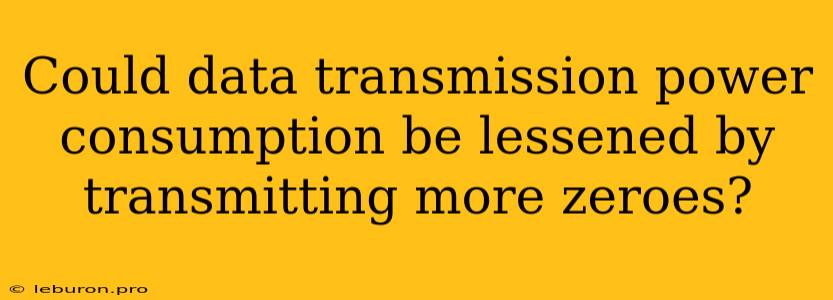The ever-increasing demand for data transmission has brought about a significant rise in energy consumption. Data centers, responsible for processing and transmitting vast amounts of information, are major contributors to global energy usage. As data transmission becomes more ubiquitous and data volumes grow exponentially, exploring ways to reduce energy consumption becomes paramount. One intriguing proposition is the potential to lessen data transmission power consumption by transmitting more zeroes. This article delves into the feasibility and potential benefits of this approach, examining the principles behind data transmission and the role of zeroes in reducing energy consumption.
Understanding Data Transmission and Power Consumption
Data transmission involves converting information into a series of electrical signals that travel over communication channels. The fundamental unit of information in digital systems is the bit, representing either a 0 or a 1. These bits are grouped into larger units like bytes, kilobytes, megabytes, and so on, forming the data that is transmitted.
The power consumed during data transmission depends on several factors, including the distance traveled, the transmission speed, and the type of communication medium used. However, a key aspect of power consumption lies in the physical representation of bits as electrical signals.
Power Consumption in Electrical Signals
When transmitting data, each bit is typically represented by a voltage level. For instance, a high voltage level could represent a 1, while a low voltage level could represent a 0. The process of switching between these voltage levels consumes energy.
Moreover, the transmission medium itself can introduce losses, further contributing to energy consumption. These losses can be due to resistance in the wires, interference from other signals, or attenuation of the signal strength over distance.
Zeroes and Data Transmission: A Closer Look
Now, let's consider the role of zeroes in data transmission power consumption. While both 0s and 1s require energy to transmit, there is a subtle difference.
The Power Advantage of Zeroes
In many digital systems, representing a 0 requires less energy than representing a 1. This is because:
- Voltage Levels: Zeroes often correspond to a lower voltage level, which typically requires less energy to maintain.
- Switching Costs: Switching from a high voltage level (representing a 1) to a low voltage level (representing a 0) generally consumes less energy than switching from a low voltage level to a high voltage level.
These factors suggest that transmitting more zeroes could potentially lead to reduced energy consumption in data transmission.
Strategies for Transmitting More Zeroes
To leverage the potential energy savings offered by zeroes, various strategies can be employed:
1. Data Compression
Data compression algorithms are designed to reduce the size of data by removing redundancy and representing information more efficiently. Often, compression algorithms exploit the inherent redundancy in data to represent patterns of repeated bits with fewer bits. This can lead to a higher proportion of zeroes in the compressed data, potentially lowering data transmission power consumption.
2. Zero-Suppression Techniques
Zero-suppression techniques specifically target the removal of consecutive zeroes from data streams. By encoding long sequences of zeroes with special markers, these techniques can significantly reduce the number of bits transmitted while preserving the original data. This can significantly reduce the energy required for transmission.
3. Data Encoding Schemes
Different data encoding schemes can influence the frequency of zeroes in the transmitted data. Some encoding schemes, like Manchester encoding, utilize transitions between high and low voltage levels to represent both 0s and 1s. This can lead to a balanced distribution of zeroes and ones, limiting the potential benefits of transmitting more zeroes. However, other encoding schemes, like NRZI (Non-Return-to-Zero Inverted), can introduce more zeroes by representing a 1 with a transition and a 0 with a constant voltage level.
Challenges and Considerations
While transmitting more zeroes holds promise for reducing data transmission power consumption, several challenges and considerations need to be addressed:
- Data Sensitivity: Not all data can be easily compressed or manipulated to increase the frequency of zeroes. For example, highly sensitive data, such as encrypted information, may require specific encoding schemes that cannot be easily altered.
- Overhead: Compression and zero-suppression techniques often introduce overhead in the form of additional bits or markers to signal the presence of compression or zero-suppression. This overhead can offset some of the potential energy savings, especially for small data packets.
- Compatibility: Different communication protocols and systems may have varying levels of support for compression or zero-suppression techniques. Compatibility issues can hinder the widespread adoption of these methods.
- Computational Complexity: Implementing compression and zero-suppression algorithms can require additional computational resources, potentially increasing energy consumption at the source and destination devices.
Conclusion
Transmitting more zeroes presents a promising avenue to reduce data transmission power consumption. By leveraging data compression, zero-suppression techniques, and suitable encoding schemes, it's possible to optimize data transmission for greater energy efficiency. However, challenges related to data sensitivity, overhead, compatibility, and computational complexity need careful consideration. As data transmission continues to grow, exploring and refining strategies to transmit more zeroes will become increasingly crucial for a sustainable future of data transfer. Further research and development are needed to overcome these challenges and fully realize the potential of this approach.
